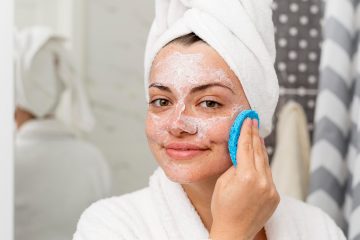In a world of endless skincare products, beauty blogs, and influencer recommendations, it’s easy to feel overwhelmed when trying to figure out the best skin care routine for you. We all want radiant, healthy skin, but with so many options, how do you create a routine that works for your unique skin type and needs?
The good news is, building a skin care routine doesn’t have to be complicated. Whether you have dry, oily, combination, or sensitive skin, there’s a simple, step-by-step routine that can help you achieve that glow you’ve been dreaming of. The key is understanding the basics of skincare and customizing the routine to suit your personal needs.
In this guide, we’ll break down the essential steps of an effective skin care routine and provide tips for every skin type so you can design a regimen that works for you. Ready for beautiful, glowing skin? Let’s get started!
1. Start with Cleansing: The Foundation of Your Routine
Cleansing is the first and most important step in any skincare routine. It removes dirt, oil, makeup, and impurities that accumulate on your skin throughout the day. Proper cleansing ensures that your skin is prepped and ready to absorb the nutrients from the products you apply afterward.
How to Choose the Right Cleanser:
- Oily Skin: Look for a foaming or gel-based cleanser that can deeply cleanse without stripping moisture.
- Dry Skin: Choose a hydrating, creamy cleanser that will remove impurities without drying out your skin.
- Combination Skin: A gentle, balancing cleanser works best to address both the oily and dry areas of your face.
- Sensitive Skin: Go for a fragrance-free, soothing cleanser with calming ingredients like aloe or chamomile.
How to Cleanse:
- Wet your face with lukewarm water.
- Apply a small amount of cleanser and massage it into your skin in circular motions for 30 seconds to 1 minute.
- Rinse thoroughly with water and pat your face dry with a clean towel.
2. Exfoliate: Reveal Fresh, Radiant Skin
Exfoliation is an essential step that helps slough off dead skin cells, unclog pores, and promote cell turnover. It can leave your skin feeling smooth, glowing, and refreshed. However, exfoliation should be done in moderation—too much can irritate the skin, while too little can lead to dullness and clogged pores.
How Often to Exfoliate:
- Oily or Acne-Prone Skin: 2-3 times a week to help with excess oil and clogged pores.
- Dry Skin: 1-2 times a week to avoid irritation and dryness.
- Sensitive Skin: Once a week or every other week to avoid sensitivity or redness.
How to Exfoliate:
- Use a gentle scrub (physical exfoliator) or a chemical exfoliator with ingredients like AHAs (alpha hydroxy acids) or BHAs (beta hydroxy acids) like salicylic acid.
- Apply the exfoliator to clean, damp skin and gently massage for a minute. If using a chemical exfoliator, leave it on for the recommended time and rinse off.
- Follow with your toner or serum, and don’t forget sunscreen (more on that later!).
3. Toner: Balance Your Skin’s pH
Toners have come a long way from their harsh, alcohol-based formulas. Today, they are packed with nourishing ingredients that can hydrate, balance, and soothe your skin after cleansing. Toner helps restore your skin’s pH balance, tightens pores, and preps your skin to better absorb the rest of your skincare products.
How to Choose the Right Toner:
- Oily Skin: Look for a toner with salicylic acid or witch hazel to help control oil production and keep pores clean.
- Dry Skin: Go for a hydrating toner with ingredients like glycerin, aloe vera, or rose water.
- Combination Skin: A balanced toner with soothing ingredients like chamomile or green tea works well.
- Sensitive Skin: Choose an alcohol-free, calming toner with hydrating ingredients like hyaluronic acid.
How to Apply Toner:
- Apply a few drops to a cotton pad or your hands and gently pat it into your skin.
- Let it absorb fully before moving on to the next steps.
4. Serums: Targeted Treatment for Your Skin Concerns
Serums are packed with concentrated ingredients that address specific skin concerns like fine lines, hyperpigmentation, acne, or dullness. Whether you want to boost hydration, brighten your complexion, or combat signs of aging, serums are your go-to product for targeted treatment.
How to Choose the Right Serum:
- For Hydration: Look for hyaluronic acid or glycerin.
- For Acne: Choose a serum with salicylic acid or niacinamide to control breakouts.
- For Anti-Aging: Retinol or peptides are great options to reduce fine lines and stimulate collagen production.
- For Brightening: Vitamin C is known for its brightening and antioxidant properties, helping to even out skin tone and fade dark spots.
How to Apply Serums:
- After toning, apply a few drops of serum to your face and neck. Gently press it into your skin, focusing on areas of concern.
- Serums are usually lightweight, so allow them a minute or so to absorb before moving on to moisturizer.
5. Moisturizer: Lock in Hydration
Moisturizer is a crucial step in every skincare routine. It helps to lock in moisture, hydrate the skin, and create a barrier that keeps environmental aggressors (like pollution and UV rays) from damaging your skin. Even if you have oily skin, don’t skip this step! The right moisturizer can balance oil production and keep your skin hydrated without feeling greasy.
How to Choose the Right Moisturizer:
- Oily Skin: Look for an oil-free or gel-based moisturizer that hydrates without clogging pores.
- Dry Skin: Opt for a richer, cream-based moisturizer with ingredients like shea butter or ceramides to lock in moisture.
- Combination Skin: A lightweight, non-comedogenic moisturizer works best for balancing both dry and oily areas.
- Sensitive Skin: Choose a soothing, fragrance-free moisturizer with calming ingredients like calendula or chamomile.
How to Apply Moisturizer:
- After your serum has fully absorbed, apply a generous amount of moisturizer to your face and neck.
- Gently massage it in, moving upwards to lift and firm the skin.
6. Eye Cream: Target the Delicate Under-Eye Area
The skin around your eyes is thinner and more sensitive than the rest of your face, so it needs extra care. Eye creams are formulated to address common concerns like puffiness, dark circles, and fine lines. While eye creams aren’t a magical cure-all, they can help hydrate and protect this delicate area.
How to Choose the Right Eye Cream:
- For Dark Circles: Look for ingredients like vitamin C, caffeine, or licorice extract to brighten the under-eye area.
- For Puffiness: Choose an eye cream with caffeine or cooling ingredients to reduce swelling and promote circulation.
- For Wrinkles: Retinol or peptides are excellent for promoting collagen production and reducing fine lines.
How to Apply Eye Cream:
- Use your ring finger to gently tap a small amount of eye cream around the under-eye area, avoiding direct contact with the eyes.
- Pat it in gently, never rub, to avoid irritating the skin.
7. Sunscreen: The Non-Negotiable Step
The most important step in any skincare routine is protecting your skin from the sun. Sunscreen is essential for preventing premature aging, dark spots, and skin cancer. Make sure to apply sunscreen every day, even when you’re indoors or it’s cloudy outside. UV rays can damage your skin even through windows!
How to Choose the Right Sunscreen:
- For Oily Skin: Choose a mattifying sunscreen with a lightweight, non-greasy formula.
- For Dry Skin: Go for a hydrating sunscreen with added moisturizing ingredients.
- For Sensitive Skin: Opt for a mineral sunscreen (zinc oxide or titanium dioxide) that’s gentle and free of fragrances.
How to Apply Sunscreen:
- Apply sunscreen as the final step in your morning skincare routine. Use a generous amount—at least a nickel-sized dollop for your face.
- Reapply every two hours if you’re outdoors or sweating.
Bonus: Night Care for Deeper Restoration
At night, your skin goes into repair mode, so it’s a great time to use more nourishing products. Consider incorporating a night cream with ingredients like peptides, retinol, or hydrating oils. If you’re concerned about fine lines, retinol can be a powerful addition to your routine (but be sure to start slowly, as it can be irritating to the skin).
Final Thoughts: A Skincare Routine That Works for You
Building a skincare routine is all about understanding your skin’s needs and finding products that work for you. Consistency is key—no routine will give you overnight results, but with time, you’ll see a noticeable improvement in your skin’s texture, hydration, and overall appearance.
Remember, skincare isn’t a one-size-fits-all approach. It’s about trial and error, finding what works best for your skin, and loving yourself through the process. With the right routine, you’ll not only have glowing skin, but you’ll also build a self-care habit that enhances





